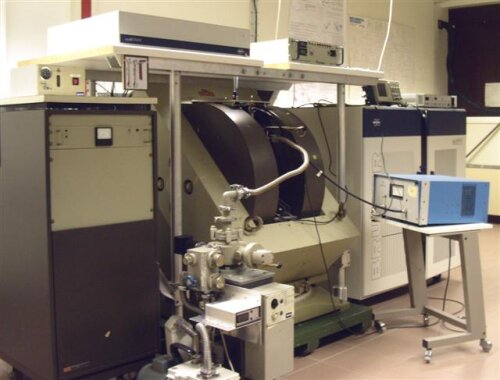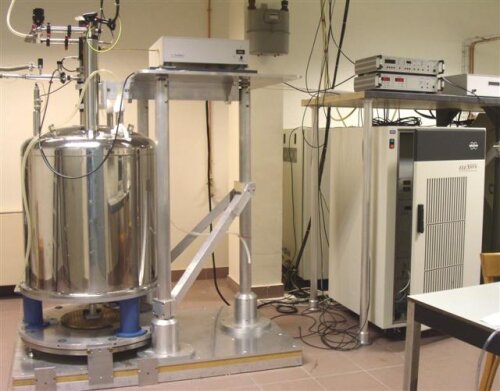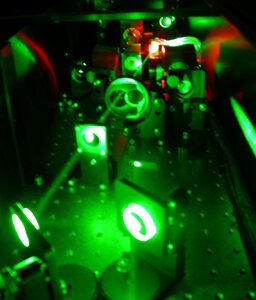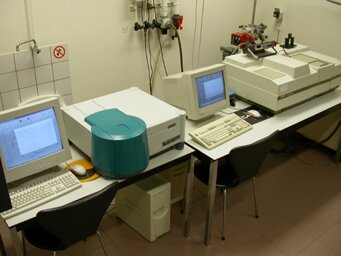Uitrusting
Onze laboratoria omvatten deze uitrusting:
X-band (9.5 GHz) EPR & ODMR/EDMR setup

Our Bruker CW EPR spectrometer in the X-band (9.5 GHz), originally installed to study the photographic process in collaboration with Agfa-Gevaert, is now a general purpose instrument for measurements in the range 2.5-298K.In this instrument, we have implemented optically detected magnetic resonance (ODMR) and electrically detected magnetic resonance (EDMR) in which the spin dependence of emitted light intensity from a sample (in ODMR) or of electrical current through a material (in EDMR) can be detected. This is applied in particular for the study of spin dependent processes in carrier recombination and transport in organic materials.
Pulsed X-band (9.5 GHz) EPR & ENDOR setup
Pulsed X-band (9.5 GHz) EPR & ENDOR setup

The Bruker ESP380E spectrometer is operational in CW and pulsed EPR mode. The microwave bridge has four tunable microwave-pulse channels allowing for advanced pulsed EPR experiments. Using an Oxford Instruments flow cryostat measurements can be done in the 4-298 K range. This instrumentation was upgraded to an Elexsys Bruker system thanks to funding of the Hercules Foundation allowing both pulsed EPR and ENDOR at variable temperatures.
CW and pulsed W/X-band EPR & ENDOR & ELDOR setup
CW and pulsed W/X-band (95/9.5 GHz) EPR & ENDOR & ELDOR setup; also ODMR and transient EPR in W-band

The W-band (95 GHz) EPR spectrometer (Bruker bridge, Oxford superconducting magnet) is operational in continuous-wave and pulsed mode. Optically detected magnetic resonance (ODMR) is possible using either a Fabry-Perot cavity or a cylindrical cavity (1). PELDOR and pulsed ENDOR experiments are also possible. All EPR, ENDOR, PELDOR and ODMR measurements can be performed in the 1.5-300 K temperature range, with facilities for orientational studies of small single crystals. The basic W-band instrument was purchased for fundamental research in condensed matter thanks to support from the Fund for Scientific Research -Flanders (FWO).Research is performed in collaboration with Belgian and International Research on a wide range of topics, both in basic and applied science. The W-band set-up has recently been extended to an X/W-band combined system thanks to an investment of the Hercules Foundation, allowing also for X-band pulsed EPR, PELDOR and pulsed ENDOR at variable temperature.
Femtosecond and Picosecond Pulsed Laser Lab

Ultrashort laser pulses are available over a wide range of wavelengths extending from the UV to the mid-IR, through a variety of lasers, nonlinear optical frequency conversion processes, and a state-of-the-art regenerative amplifier system. These short light pulses are used for time-resolved optical spectroscopy, and for nonlinear optical (NLO) spectroscopy. Time-resolved luminescence measurements are performed using a streak camera (Hamamatsu Streakscope) which allows for the parallel detection of the luminescence spectrum as a function of time (~20ps resolution). Even higher time resolution, only limited by the duration of the laser pulses (<80fs from a mode-locked Ti:sapphire laser), is achieved with "pump-probe" measurements. In such measurements, a first pulse excites the sample and a second pulse, delayed by making it traverse a longer distance, is used to probe the light-induced changes in the sample as a function of time. In NLO spectroscopy, such as second-harmonic light scattering (Hyper-Rayleigh scattering), use is made of the extremely high peak-intensities reached in these ultra-short light pulses, leading to new "nonlinear" phenomena not occurring at more usual intensities.
Raman Spectroscopy

Our Raman scattering spectrometer is an 80cm Dilor XY-800, with triple monochromator allowing for multi-channel liquid nitrogen cooled CCD detection or single-channel PM detection. Four different lasers can be used as light source in a wide range from violet to NIR. This too is a much-used standard research tool with exceptional features.
Standard optical absorption and fluorescence spectrometers
Standard optical absorption and fluorescence spectrometers

This Varian Cary 5E optical absorption spectrometer is a standard research tool with a wavelength range from 175nm to 3300nm. It is applied to various transparant samples including crystals, liquid solutions, and polymer films.A Varian Cary Eclipse fluorometer, kindly shared by the Structural Chemistry group of Profs. Geise and Blockhuys, allows for steady state fluorescence and phosphorescence measurements. Luminescence measurements by means of parallel CCD detectors are also frequently used. Absorption and luminescence measurements are performed at temperatures between 10K and room temperature.
Visible and near-infrared fluorescence spectroscopy with high sensitivity and throughput
Visible and near-infrared fluorescence spectroscopy with high sensitivity and throughput
Optimising the excitation source(s), the illumination and collection geometry, and the detectors an instrument for fluorescence measurements in the visible and near-infrared (350-2200 nm) has been developped with very high sensitivity and sample througput.As a flexible source, a Xe flash-lamp with monochromator is chosen for high intensity illumination at a chosen wavelength, but also various laser sources can be coupled onto the sample.The excitation and collection assembly is home built with parabolic mirrors for optimal efficiency.Parallel detection of the spectra is performed with array detectors in the visible (cooled Si CCD detector) and in the near-infrared (cooled InGaAs diode array).